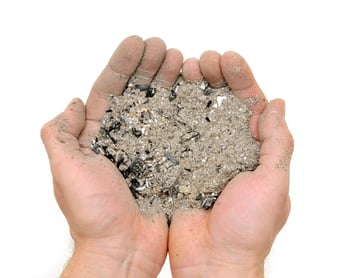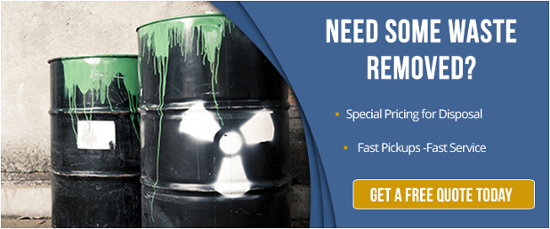Almost every company generates non-hazardous waste.
Whether it’s the paper used to generate invoices, cardboard that’s no longer needed after receiving shipments, discarded food from the employee breakroom or even industrial materials that don’t meet the threshold to be considered hazardous in the state of California.
However, just because a type of waste isn’t considered “hazardous” according to state and federal standards does not mean it does not pose some level of risk to the environment and community at large. And it certainly doesn’t mean that proper non-hazardous waste disposal isn’t warranted.
Here are five non hazardous waste examples your company may generate and why the proper disposal of this waste is important to meet your sustainability goals and protect the community you serve.
1. E-Waste
E-waste is a common type of waste found in many different types of facilities, whether it’s office space, manufacturing facilities or medical buildings.
facilities, whether it’s office space, manufacturing facilities or medical buildings.
In fact, nearly 53.6 million metric tons of e-waste was generated worldwide in 2019. That’s equivalent to the weight of 350 cruise ships worth of electronics products, according to Fast Company.
Typical types of e-waste include televisions, computer monitors and towers, printers, lamps and hospital equipment. There are no federal laws that dictate the recycling of electronics. However, 25 states have put into place electronics recycling laws, including California.
Although California considers e-waste to be generally hazardous, there are some forms of e-waste that are non-hazardous. They typically are components of an electronics device, such as:
- Zinc plating, often found in steel production parts
- Aluminum, often found in electronic goods
- Copper and gold, regularly used in computer parts
- Plastic and glass components found on electronics
Many facilities will recycle these components, and you may even be able to profit off these materials depending on their form and quantity.
Why proper disposal is important: Because the examples above refer to parts, and not the electronic device as a whole, it can be difficult, time consuming and potentially dangerous to separate the non-hazardous parts from the hazardous parts. Discarding the entire device will likely put you in violation of hazardous waste laws. It’s simply better to recycle your electronic waste at a facility that accepts it or enlist the help of a hazardous waste disposal company to properly remove the products from your facility.
2. Medical Waste
While some medical waste is often thought of as being hazardous, the reality is that the majority of it is not considered hazardous. In fact, according to the World Health Organization, approximately 85% is not classified as hazardous.
the reality is that the majority of it is not considered hazardous. In fact, according to the World Health Organization, approximately 85% is not classified as hazardous.
Examples of non-hazardous medical waste include plastic packaging, clean glass and plastic, paper and cardboard, food scraps and office products. In California, aerosol cans are not considered hazardous as long as they are completely depleted.
Especially in hospitals and medical facilities, kitchen waste and solid waste account for a hefty portion of the waste. According to the U.S. Environmental Protection Agency, hospitals are responsible for 170,000 tons of food waste each year.
Why proper disposal is important: When it comes to food waste at medical facilities, managing the amount of waste that goes into landfills is important. That’s because food waste is estimated to be responsible for 20% of all methane emissions. To help offset this, many hospitals and medical facilities have established recycling programs to tackle food waste.
When it comes to other types of medical waste, identifying the waste is critical to ensuring it is properly disposed of at the right locations. Remember, 15% of medical waste is considered hazardous material that may be toxic, infectious or even radioactive.
Working with a reputable disposal company can help identify these wastes through sampling and testing. A disposal company can also properly remove large quantities of waste like cardboard boxes that simply won’t fit in trash receptacles on the property. It can be extremely costly for a company to have the number of receptacles needed to handle the amount of medical waste generated.
3. Secondary Materials
As part of the EPA’s Sustainable Materials Management effort, reusing secondary materials that are non-hazardous can help preserve vital resources.
Secondary materials are not primary products that a company produces, and are instead scraps or residuals that are the result of a production process. These include coal combustion residuals, often generated by steam electric utilities, and spent foundry sand, which comes from the metal casting industrial sector.
Construction materials that accumulate when infrastructure, including building and roads, are demolished or constructed can also be reused.
Why proper disposal is important: Secondary materials are valuable across several industries. Rather than being discarded in a landfill, these materials can be used as a substitute for an original material since many retain the same physical and chemical properties. Construction crews also can use them to build roads and other infrastructure, such as pavement, bridges and buildings.
4. Industrial Materials
Most states classify common industrial materials as non-hazardous. These include ash, sludges, antifreeze, grinding dusts and liquids contaminated with non-hazardous chemicals.
These include ash, sludges, antifreeze, grinding dusts and liquids contaminated with non-hazardous chemicals.
One industrial material that is considered non-hazardous in some states is asbestos. Asbestos is a heat-resistant fibrous silicate mineral. It’s often used in fire-resistant and insulating materials.
In California, asbestos is considered to be hazardous. It’s important to know the laws of each state because of this. While one industrial material may be non-hazardous in one state, it may be considered hazardous in another. There also may be various rules that dictate disposal depending on quantity of the material. For example, in California, only asbestos waste weighing more than 50 pounds requires transportation by a certified hazardous waste disposal company.
Why proper disposal is important: While many types of industrial waste are classified as non-hazardous, they can still be harmful to the environment and human health. For example, some can ignite at high temperatures or can contaminate soils. Because of this, not all types of industrial waste are accepted at local landfills. Or, certain landfills are designated to only accept certain types of industrial wastes.
Knowing where to dispose of the industrial wastes you generate can be challenging. Any mistakes you make in disposal can result in costly fines. An experienced disposal company can ensure even your non-hazardous industrial waste is properly disposed of at the right location.
5. Excluded Recyclable Materials
Some hazardous waste you generate can be considered non- hazardous. Confused? You’re not alone. Determining what is hazardous versus non-hazardous can be challenging enough. Add in how some materials begin as hazardous and become non-hazardous can be downright confusing.
hazardous. Confused? You’re not alone. Determining what is hazardous versus non-hazardous can be challenging enough. Add in how some materials begin as hazardous and become non-hazardous can be downright confusing.
There are many different hazardous waste streams that can be reclaimed and converted into usable products in order for your company to take advantage of the benefits of recycling. For example, a solvent recycling facility can distill or purify a waste solvent and then sell the product for reuse.
An important step in being able to realize the benefits of recycling hazardous waste streams involves obtaining a new classification for your waste materials. Once a Treatment, Storage and Disposal Facility (TSDF) has evaluated a substance, the facility can declare it appropriate for recycling and certify that it qualifies under the excluded recyclable materials exception.
Once this occurs, the approved waste streams can be re-classified as excluded materials and considered non-hazardous waste disposal.
Why proper disposal is important: Getting these materials properly designated for disposal is important for many companies because these materials can be excluded from hazardous waste classifications and management standards. This means that these substances are no longer included in the monthly hazardous waste measurements for hazardous waste generators.
This can change a company’s generator status from a large generator of hazardous waste to a small generator of hazardous waste. By emphasizing proper disposal, companies may experience a change in status and can realize significant cost savings since a reduction of EPA regulation requirements typically results in an increase in profitability.
How To Ensure Proper Disposal
State and federal regulations continue to change. What was once non-hazardous is now hazardous and vice versa. There are many reasons why the proper disposal of non-hazardous waste is important, from preserving the environment to saving costs. But how does a company ensure that it is taking advantage of all the benefits of proper disposal?
A disposal company experienced in non-hazardous waste and hazardous waste can help ensure your business stays up to date with any regulations that could impact the disposal or recycling of your waste streams.
To find the best disposal company for your business, here are a few tips:
- Perform a background check: At minimum, check financial references like a Dun & Bradstreet report. Ensure the vendor is properly insured and its employees are properly trained. Check for proper licensing as well, which can be done through the EPA, Department of Toxic Substances Control and the U.S. Department of Transportation.
- Check references: Ask a vendor you are considering for references, and make sure those references include non-hazardous waste similar to the type you generate.
- Look for important qualities: These include the ability to sample and test waste streams, maintain manifests and other important paperwork, and provide emergency response in the event of a spill or accident.
A qualified non-hazardous waste disposal company will have the expertise to determine whether your waste streams qualify for reclassification and money-saving options, as well as be able to ensure any waste you generate is safely and properly disposed of in a timely manner.


Comment